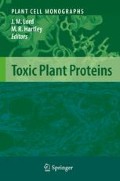Abstract
This contribution presents an updated analysis of the evolution of ribosome-inactivating proteins (RIPs) in plants. All evidence suggests that an ancestor of modern seed plants developed the RIP domain at least 300 million years ago. This ancestral RIP domain gave rise to a direct lineage of type 1 RIPs (i.e., primary type 1 RIPs) still present today in many monocots and at least one dicot. In a later stage, a plant succeeded in fusing the RIP domain to a duplicated ricin-B domain acquired from a bacterium. The resulting ancestral type 2 RIP gave rise to all modern type 2 RIPs and by domain deletion, to different lines of “secondary” type 1 RIPs and ricin-B type lectins. In the recent past, at least three other domain fusions took place in the Poaceae family, whereby type AC1 (type 3), type AC2, and type AD chimeric forms were generated.
Access this chapter
Tax calculation will be finalised at checkout
Purchases are for personal use only
Notes
- 1.
Sequences of all RIPs used in this study can be retrieved from: http://www.molecularbiotechnology.ugent.be/publications/VanDamme2010A/.
- 2.
These sequence data were produced by the US Department of Energy Joint Genome Institute, http://www.jgi.doe.gov/.
References
Barbieri L, Battelli MG, Stirpe F (1993) Ribosome-inactivating proteins from plants. Biochim Biophys Acta 1154:237–282
Chaudhry B, Müller-Uri F, Cameron-Mills V, Gough S, Simpson D, Skriver K, Mundy J (1994) The barley 60 kDa jasmonate-induced protein (JIP60) is a novel ribosome-inactivating protein. Plant J 6:815–824
Girbés T, Ferreras JM, Arias FJ, Stirpe F (2004) Description, distribution, activity and phylogenetic relationship of ribosome-inactivating proteins in plants, fungi and bacteria. Mini Rev Med Chem 4:461–476
Hey TD, Hartley M, Walsh TA (1995) Maize ribosome-inactivating protein (b-32). Homologs in related species, effects on maize ribosomes, and modulation of activity by pro-peptide deletions. Plant Physiol 107:1323–1332
Jiang SY, Ramamoorthy R, Bhalla R, Luan HF, Venkatesh PN, Cai M, Ramachandran S (2008) Genome-wide survey of the RIP domain family in Oryza sativa and their expression profiles under various abiotic and biotic stresses. Plant Mol Biol 67:603–614
Masuda S, Sakuta C, Satoh S (1999) cDNA cloning of a novel lectin-like xylem sap protein and its root-specific expression in cucumber. Plant Cell Physiol 40:1177–1181
Mishra V, Sharma RS, Yadav S, Babu CR, Singh TP (2004) Purification and characterization of four isoforms of Himalayan mistletoe ribosome-inactivating protein from Viscum album having unique sugar affinity. Arch Biochem Biophys 423:288–301
Palmer JD, Soltis DE, Chase MW (2004) The plant tree of life: an overview and some points of view. Am J Bot 91:1437–1445
Peumans WJ, Hao Q, Van Damme EJM (2001) Ribosome-inactivating proteins from plants: more than RNA N-glycosidases? FASEB J 15:1493–1506
Stirpe F, Battelli MG (2006) Ribosome-inactivating proteins: progress and problems. Cell Mol Life Sci 63:1850–1866
Stirpe F, Licastro F, Morini MC, Parente A, Savino G, Abbondanza A, Bolognesi A, Falasca AI, Rossi CA (1993) Purification and partial characterization of a mitogenic lectin from the latex of Euphorbia marginata. Biochim Biophys Acta 1158:33–39
Van Damme EJM, Barre A, Rougé P, Van Leuven F, Peumans WJ (1996) Characterization and molecular cloning of SNAV (nigrin b), a GalNAc-specific type 2 ribosome-inactivating protein from the bark of elderberry (Sambucus nigra). Eur J Biochem 237:505–513
Van Damme EJM, Barre A, Barbieri L, Valbonesi P, Rougé P, Van Leuven F, Stirpe E, Peumans WJ (1997a) Type 1 ribosome-inactivating proteins from Iris (Iris hollandica var. Professor Blaauw) bulbs: characterization and molecular cloning. Biochem J 324:963–970
Van Damme EJM, Roy S, Barre A, Rougé P, Van Leuven F, Peumans WJ (1997b) The major elderberry (Sambucus nigra) fruit protein is a lectin derived from a truncated type 2 ribosome-inactivating protein. Plant J 12:1251–1260
Van Damme EJM, Peumans WJ, Barre A, Rougé P (1998) Plant lectins: a composite of several distinct families of structurally and evolutionary related proteins with diverse biological roles. Crit Rev Plant Sci 17:575–692
Van Damme EJM, Hao Q, Charels D, Barre A, Rougé P, Van Leuven F, Peumans WJ (2000) Characterization and molecular cloning of two different type 2 ribosome-inactivating proteins from the monocotyledonous plant Polygonatum multiflorum. Eur J Biochem 267:2746–2759
Van Damme EJM, Hao Q, Chen Y, Barre A, Vandenbussche F, Desmyter S, Rougé P, Peumans WJ (2001) Ribosome-inactivating proteins: a family of plant proteins that do more than inactivate ribosomes. Crit Rev Plant Sci 20:395–465
Van Damme EJM, Lannoo N, Peumans WJ (2008) Plant lectins. Adv Bot Res 48:107–209
Walsh TA, Morgan AE, Hey TD (1991) Characterization and molecular cloning of a proenzyme form of a ribosome-inactivating protein from maize. Novel mechanism of proenzyme activation by proteolytic removal of a 2.8-kilodalton internal peptide segment. J Biol Chem 266:23422–23427
Acknowledgements
This research was supported by the Research Council of Ghent University and the Fund for Scientific Research (FWO-Vlaanderen, Brussels, Belgium).
Author information
Authors and Affiliations
Corresponding author
Editor information
Editors and Affiliations
Rights and permissions
Copyright information
© 2010 Springer-Verlag Berlin Heidelberg
About this chapter
Cite this chapter
Peumans, W.J., Van Damme, E.J.M. (2010). Evolution of Plant Ribosome-Inactivating Proteins. In: Lord, J., Hartley, M. (eds) Toxic Plant Proteins. Plant Cell Monographs, vol 18. Springer, Berlin, Heidelberg. https://doi.org/10.1007/978-3-642-12176-0_1
Download citation
DOI: https://doi.org/10.1007/978-3-642-12176-0_1
Published:
Publisher Name: Springer, Berlin, Heidelberg
Print ISBN: 978-3-642-12175-3
Online ISBN: 978-3-642-12176-0
eBook Packages: Biomedical and Life SciencesBiomedical and Life Sciences (R0)

